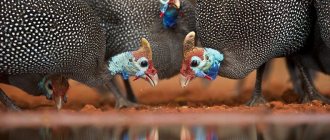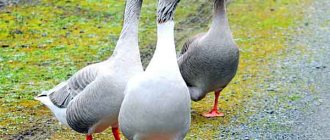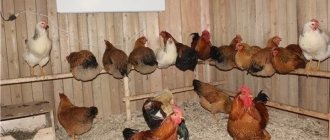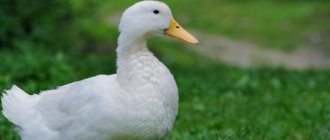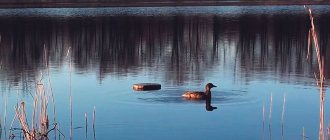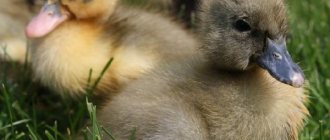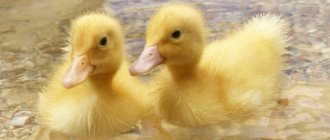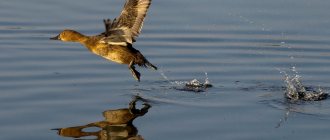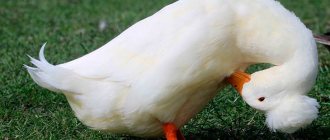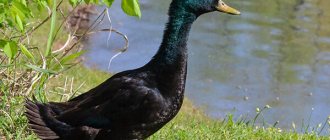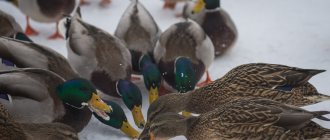Why was the Mandarin duck called that?
- The mandarin duck got its name due to its bright multi-colored plumage. In China, mandarins were the name given to wealthy noble rulers who dressed up in flashy clothes. The plumage of males has such a bright color.
- Previously, the Mandarin duck had a different name: “Mandarin” or “Chinese” duck. There is also an opinion that the duck got its name due to the fact that it was a decoration of ponds in the imperial palace and the courtyards of advisers in East Asia.
- Definitely, the name of the mandarin duck comes from its beauty and involvement in greatness and is in no way connected with the name of the citrus fruit of the same name.
Mandarin ducks
Origin story
The Mandarin duck was developed in China. In ancient times, noble people kept these birds in their artificial ponds. Mandarin ducks were considered a symbol of abundance and wealth. Ducks were expensive, so only rich people could afford them.
Many people believe that the name of the ornamental bird is associated with the type of citrus fruit of the same name, but this is not so. The duck was named after Chinese officials - mandarins. This name was given to the nobility by the Portuguese. Mandarins wore bright and luxurious clothes. The colorful clothes resembled bird feathers, so it was decided to call the beautiful ducks “mandarin ducks.” Later, these birds became a symbol of love and family happiness.
Even in ancient times, bright birds began to be bred in other eastern countries. Mandarin ducks have decorated parks and gardens in Korea and Japan for many centuries. Today, these ducks are found in different parts of the world, although many people can only see them in photographs or pictures in books.
Why is the Mandarin duck listed in the Red Book?
- This species of duck cannot be hunted - it is protected by law and is listed in the Red Book. In the autumn season, the male duck sheds his bright plumage and becomes like an ordinary duck - this is the most dangerous period for the mandarin duck, as it can become a victim of a hunter.
- Therefore, in the habitats of these ducks, the hunting season begins at the end of September: when most of the mandarin ducks leave their nests and fly to warmer climes.
- The mandarin duck takes root well and reproduces in captivity. People often get it as an ornamental bird for their artificial ponds.
- The bird is easily tamed and is a frequent inhabitant of park ponds. It is non-conflicting and gets along well with other species of waterfowl.
- Living mandarin ducks in protected areas with proper conditions helps protect the population of these rare birds.
Listed in the Red Book
Keeping at home
Colorful ducks can be raised on a farm. These exotic birds live in captivity for about 25 years. However, in order to keep them, you need to find out all the information about their character traits, food preferences and, of course, comfortable living conditions. Arrangement of the enclosure is an important point. It is advisable to recreate conditions as close as possible to those in which the mandarin duck lives in nature. As for the size of the poultry house, it should be spacious. Mandarin ducks are temperamental representatives of the fauna that actively defend their territory. They need a lot of space (minimum 9 m² for one pair). Otherwise, you may encounter the problem of bird aggression during the breeding season. Both males can fight for a place for mating games, and females can fight for choosing a nest.
To arrange nests, trees or their substitutes are needed. Wooden posts or logs can be used as the latter. The nests themselves should be located at a height of at least 1.5 m from the ground. Only in such conditions will the female feel that both she and her future babies are safe. If you are breeding a large number of individuals, it is better to create nests at different heights so that each female can choose the option that is convenient for herself.
It is also advisable to ensure that there is a place near the nest for comfortable landing. Under natural conditions, this function is performed by tree branches. If a pole is used, additional planks have to be constructed. Instead of nests, you can build small cozy houses
To prevent the mandarin duck from flying away into the wild, it is worth paying attention to the sufficient height of the walls of the enclosure. The ideal option is a covered space
The roof will protect your pets from precipitation, which will increase their level of comfort. As for their proximity to other breeds, mandarin ducks are very friendly. They easily get along with other birds both in natural and artificially created conditions. The main thing is that the tangerine nests are inaccessible to other feathered inhabitants of the enclosure.
If there is no natural body of water nearby, a swimming pool should be provided. To do this, you need to dig a hole about 4 meters deep in the enclosure. The width of the recess should be about 1.5 meters. The walls of an artificial pond are best made of concrete. Don't forget to make a hole for drainage. You can fill the pool with water using a regular hose. The reservoir does not have to be empty. You can place appropriate vegetation in it, as well as small insects that the ducks will feed on. Don't forget about hygiene. The pool should be cleaned every 3 weeks.
If in winter the temperature does not drop below 5 degrees below zero, keeping birds outside is acceptable. However, in this case, the walls and floor of the poultry house should be insulated with hay or straw. If the winters are colder, it is necessary to move the ducks indoors, where they will be provided with comfortable wintering conditions. Ideally, birds should be moved when the air temperature is zero.
An important point in breeding decorative ducks is proper feeding. The bird's diet should contain grain (wheat, corn, rice, barley, etc.). The meal also includes vegetables and root vegetables, which are mixed and served along with grass, ground into flour, and plantain leaves. Tangerines are very fond of clover and alfalfa. The birds are given cottage cheese and low-fat kefir in small quantities. As noted earlier, poultry protein is obtained from fish products or minced meat. However, the share of the latter in the total diet should not exceed 16-18%.
If your pet seems lethargic and refuses to eat, it should be seen by a doctor. But in general, representatives of this breed rarely get sick. It is worth noting that with poor care and improper feeding, the risk of disease increases. Also, in such conditions, the life expectancy of birds is reduced. The most common problems of birds that a poultry farmer may encounter are vitamin deficiency, rickets, hepatitis, and helminths. To prevent such troubles, you should take care of the cleanliness of the aviary and pond, fight rodents, do not neglect mineral and vitamin supplements, and provide the birds with adequate nutrition. Breeding exotic mandarins is not too difficult. The purchase of one individual bird will cost a poultry farmer just over $100. Of course, to produce offspring you need a couple. Selling colorful beauties will quickly recoup expenses
Best articles: Which trees are the tallest on Earth - list, characteristics and photos
The main thing is to provide them with proper care and attention.
To learn how to properly care for a Mandarin duck at home, watch the following video.
Mandarin duck: female and male, photo
Mandarin duck - male
- The male and female mandarin ducks have different plumage. During the mating season, the male's color becomes beautiful and bright. This sets it apart from all birds of the duck family.
- The drake has a large crest , and distinctive orange sideburns on its neck. The same orange fan is located at the end of the bird's wing. When the wings are folded, the last feather protrudes from the wing in the shape of a kind of fan.
- If you look closely, these fans on both sides form a saddle-like shape on the back of the bird. The coloring of the mandarin drake consists of purple, white, brown, orange-red and green feathers. Some of the feathers have smooth color transitions.
- The mandarin duck's legs are yellow and its beak is red. This characteristically distinguishes him from the female during the period of shedding her plumage. It must be said that the molting process in males occurs twice a year.
- In addition to traditional coloring, there are white mandarin ducks. You can recognize them by the characteristic plumage saddle on their back. Among white drakes, a characteristic feature is cream spots on the plumage.
Drake
Mandarin duck, female
- The female's color is not as variegated as the drake's. The female mandarin duck has a more subtle silhouette.
- The crest on her head is not as impressive as that of the male. The plumage on the head is gray. Along the back of the female there is a feather of a brown-olive hue with ripples.
- The lower part of the body has white plumage on the abdomen.
- Such a discreet outfit helps the bird at the moment of hatching eggs with chicks; it becomes almost invisible to predators.
Gray female
Appearance and features
Photo: Mandarin duck bird
This bird has a length of forty to fifty centimeters. The average wingspan is 75 cm. The weight of an adult is 500-800 g.
The male's head with a red beak has a variety of colors. On top it is covered with longer feathers of red tones with green and purple tints. On the sides, where the eyes are, the feathers are white, and closer to the beak they are orange. This color fans out further up the neck, but towards the back of the neck it changes abruptly to green-blue.
Two white stripes run parallel on the purple chest. The sides of the male bird are brownish-red with two orange “sails” that are slightly raised above the back. The tail is blue-black. The back has feathers of dark, black, blue, green and white colors. The abdomen and undertail are white. The legs of the male bird are orange.
Females of more modest appearance are dressed in speckled, gray plumage. The head with a dark gray beak has a barely noticeable crest of long feathers drooping downwards. The black eye is bordered with white and a white stripe descends from it to the back of the head. The back and head are colored gray more evenly, and the throat and breast are interspersed with feathers that are lighter in tone. There is a blue and greenish tint at the end of the wing. The female's paws are beige or gray.
Males show off their bright plumage during the mating season, after which molting occurs and waterfowl dandies change their appearance, becoming as inconspicuous and gray as their faithful friends. At this time, they can be distinguished by their orange beak and the same legs.
Interesting fact: In zoos and city reservoirs you can find white individuals, this is due to mutations that occur from closely related relationships.
Mandarin ducklings are very similar to other young of related species, such as mallards. But in baby mallards, a dark stripe running from the back of the head passes through the eye and reaches the beak, and in mandarin ducks it ends at the eye.
Mandarin duck: where does it live and what is it interesting about?
- Initially, the Mandarin duck inhabited the southern regions of East Asia, and then its population spread throughout Korea, China, Japan and part of Russia. Mandarin ducks living in the northern regions migrate to the southern regions of Japan and China by the end of September.
- And only at the very beginning of March, when the snow has not yet completely melted, do the ducks return to their native nests. This type of duck is interesting because it is able to live high in a tree. In some cases, mandarin ducks nested at a height of about 6 m above the ground.
- This way of life allowed the birds to tame their chicks to heights, almost from the first days of life - the chicks can jump from the nest without injuring themselves.
Habitat of the mandarin duck in Russia
- Mandarin ducks living in Russia choose Primorsky and Khabarovsk territories for nesting.
- Their settlement can also be found in the Sakhalin and Amur regions. Northern territories are preferred by the mandarin duck, which leads a migratory lifestyle.
Where should these birds be kept?
Mandarin ducks in an aviary in winter
Such ducks can be kept at home in special cages or open enclosures, which are equipped with a roof to protect them from precipitation. It is necessary to place a container of water in the bird house.
These ducks can be released into open water during the warm season. They get along well with other waterfowl. If there is no body of water nearby, then it is best to build a small pool yourself right in the enclosure. To do this, dig a hole 0.3-0.4 m deep and 1.5 m x 1.5 m in size.
Make the walls for the pool from concrete. Also, additionally equip a hole for drainage. Fill the container using a regular hose. It is recommended to clean such a homemade pool once every 2-3 weeks.
Pool for tangerines in an aviary
It is best to place a nest for ducks on a small hill, since in natural conditions mandarin ducks build houses on branches or in hollows of trees.
As the air temperature drops to +5°C, it is recommended to move the ducks indoors, where the most optimal conditions for the birds can be created.
In most cases, tangerines tolerate moderate frosts well. If the air temperature does not drop below -7°C...-8°C, then keeping ducks is possible even in outdoor conditions. In this case, you need to insulate the enclosure with a bedding of hay or straw. You also need to make sure that the water in the bird pool does not freeze, so you need to add hot liquid from time to time.
Where does the mandarin duck build a nest, what do the chicks look like?
- The nesting period of mandarin ducks begins in April and ends in June. Ducks make their nests in coniferous or deciduous forests, on tall trees, not far from the water. As a rule, the territory for their hollow is a quiet and cozy place, overgrown with bushes or littered with branches.
- A tall tree with branches hanging over the water is ideal When making a seasonal migration, the mandarin duck can settle along rivers and reservoirs with dense thickets in the coastal zone. It is often found in riverine areas of mountain rivers.
Mandarin duck nest and chicks
- During one clutch, a female mandarin duck lays up to 14 eggs and incubates them for a month. Throughout this period, the female does not leave the laying site. The male’s task is to provide food for the female during the brooding period.
- When the chicks are born, both parents begin the process of caring and feeding the offspring, which lasts from 35 to 45 days. It must be said that mandarin ducks are excellent parents; they do not abandon their offspring and help each other in the educational process.
- At the fortieth day of life, the chicks make their first flight attempts. At this time, the chicks do not yet have sufficient plumage and not only their wings, but also the membranes on their feet help them plan their flight. Thus, the female tames them to swim and obtain food independently.
- However, it is not always possible to preserve the offspring - mandarin duck chicks sometimes become victims of attacks by wild animals. In their natural habitat, the enemies of mandarin ducks are squirrels - nest destroyers, raccoon dogs, birds of prey, foxes and raccoons.
Duck breeding
Little mandarin ducks return from warm regions very early, when the snow around them has not yet completely melted. Immediately after their arrival, the mating season begins. Males compete fiercely and compete for females. The strongest one wins, and the duck is allowed to mate. During mating games, males make specific sounds: they do not quack, but whistle or squeak. The copulation process can last several days.
Ducks lay from 7 to 14 eggs. They make nests in hollows and incubate their offspring for 30-32 days. Males take an active part in raising ducklings. While the duck sits on the eggs, the drake looks for food and brings it to his friend. It guards the nest, scares away small predators and warns the female of danger. The picture of a drake guarding a duck looks very touching. Outside their natural habitat, as many facts say, mandarin ducks can lose their parental instinct, which is why they are so difficult to breed in captivity.
Little ducklings are born very strong. They jump out of the nest on their own; almost not a single chick is broken after falling even from a 10-meter height. Males and females work together to care for their young. They take them out to the pond in the morning and evening hours. Already on the fortieth day after birth, a mandarin duck chick can fly. In the fall, they can easily fly to warmer climes with their parents.
What is the size and weight of a mandarin duck, what is its wingspan?
- The Mandarin duck is an excellent swimmer and the bird is an excellent diver. However, she dives extremely rarely, only if she is in danger. In addition, its flight is fast, easy and maneuverable; from a standing position, the duck takes off in a vertical body position.
- The mandarin duck moves well both in water and on land. The small size of the bird's body allows it to fly among forest thickets and trees. And the low weight makes it possible to freely jump over tree branches.
- The bright duck weighs no more than 800 g, and its body size reaches 50 cm. At the same time, its wingspan in length is 60 cm. The female and drake of this breed of ducks have almost the same body weight and size.
Ducks feel great both on land and in water
Features of behavior
Mandarin ducks are strikingly different from other ducks in appearance and behavior. Individuals do not know how to quack; they are capable of making sounds reminiscent of a soft whistle or squeak. Ducks prefer to settle in trees, and hollows are chosen at a distance of 6 to 10 meters from the ground. Chicks learn to swim from an early age, and to do this they first jump from a hollow. Although their wings have not developed well enough, with their help, as well as thanks to the membranes on their paws, the ducklings glide. They manage to land unharmed.
Ducks like to live next to mountain rivers with branches hanging over them. Mandarin ducks prefer riverine forest areas, as well as reservoirs littered with windbreaks.
Individuals fly, swim and dive well. They can easily rise into the air, while flying quickly and deftly. Mandarin ducks like to jump on trees, and thanks to their low weight, it is not difficult to fly from branch to branch. They will dive only if necessary, when there is a real threat to life.
Natural enemies include foxes, raccoon dogs, and birds of prey. Squirrels also harm mandarin ducks, as they often destroy nests.
How many years does a Mandarin duck live?
- The average lifespan of these ornamental birds in their natural habitat does not exceed 6 years. This period is due to the fact that this type of duck often becomes the prey of predatory animals.
- In captivity, the Mandarin duck can live for about 12 years. But for this, she needs to provide all the conditions for comfortable living, and especially a favorable wintering. Often special wooden houses with straw flooring and heated water in a pond or a special enclosure for swimming are used.
Lifestyle
Like other species of ducks, mandarin ducks float perfectly on the water, and if necessary, they easily take off into the air without needing a run-up. Birds also spend a lot of time in coastal forests and on rocks. They easily maneuver among trees and hold tightly to branches while resting. If birds feel danger, they hide in the bushes or dive into a pond.
These ducks are silent and cautious. They rarely speak up. But sometimes they make a quiet sound, reminiscent of a melodic whistle.
The hollow that birds use to create a nest is used by them only once a year. They are looking for a new place to hatch their next offspring.
In June, males begin their molting period. They gather in a flock and hide among the thickets. The bright coloring gives way to gray-brown plumage, like that of females.
In natural conditions, mandarin ducks live up to 10 years. Their natural enemies are birds of prey and rodents. These animals destroy ducks' nests and prey on their chicks. Birds are also attacked by raccoons, foxes, minks, ferrets, otters and raccoon dogs. In addition, bird nests are often destroyed by squirrels .
What does the Mandarin duck eat?
- The diet of mandarin ducks in their habitats is rich in a variety of plant and protein foods. These birds love to eat acorns, but also feast on berries, grains and seeds of wild and cultivated plants. They love to eat fish and seafood: crayfish, shellfish.
- Worms, frogs, bugs and other insects are also desirable food for tangerines. Sometimes mandarin ducks flock to crop and winter fields to search for food - rice cereals and buckwheat, attracting ducks with their shoots.
- In nature reserves or private reservoirs, ornamental birds are fed food similar to what they receive in the wild habitat: corn, barley, rice, wheat - in solid and boiled form, acorns, grated vegetables, salads from dandelion and other greens, bran, duckweed . During nesting, the diet is expanded with the addition of fish fillets and ground meat.
Food from the environment
Habits and lifespan
One of the distinctive features of the mandarin duck is its ability to take off vertically. The bird's maneuverability is determined by its ergonomics and compact body. Grown-up ducks are able to jump on branches and fly from one tree to another.
In addition, the tangerine bird is an excellent swimmer and dives when danger appears.
Life expectancy, provided that the bird is kept in the wild, is about 10 years. As practice has shown, mandarin ducks do not reproduce well in enclosed spaces, they wither away, captivity affects their plumage - it becomes dull and deteriorates. For this reason, breeders create the most natural conditions for these ducks. With proper care, the absence of predators and good food can extend the life of the bird to 25 years.
The Mandarin duck gets along with other domestic birds: ducks, geese, chickens. She can often be seen surrounded by ducklings of a different breed, because her maternal instinct is well developed. The female is capable of raising young from other birds.
Mandarin duck: interesting facts for children
- In nature, extremely rare, there is a variety of “albino” mandarin ducks: with a completely white plumage color.
- The call these birds make is actually different from the quack of a duck. This is a sound that is more like a whistling squeak.
- The mandarin duck's small set of chromosomes does not allow it to interbreed with other species of the duck genus.
- When the mandarin drake molts, its plumage takes on a grayish tint and resembles a wild duck in appearance. It is difficult for a hunter to distinguish him. Therefore, the drake becomes a frequent prey for hunters.
- The decrease in the population of these rare ducks is associated with the destruction of forests, cutting down trees reduces nesting opportunities.
- In China, there is a tradition of giving tangerines to newlyweds for their wedding, symbolizing certain wishes. It is believed that rare birds will bring fidelity to the young family and prosperity in marriage. In fact, this sign does not correspond to reality; the devotion of the male and female mandarin ducks is not so long-lasting - they change pairs every year.
- After the change of plumage, the mandarin drake can be distinguished from the female only due to its red beak.
- Mandarin ducks do not like to nest in the same place: every year they choose a new trunk up to 6-15 meters high. They love to create hollows in oak trees.
Useful articles for children:
- Essay on the topic “The feat of Ivan Susanin”
- Origami: how to make origami
- How to make a dog out of paper
- Essay on the topic “My favorite school”
- Words that have multiple meanings: examples
- Interesting facts that can intrigue - the best selection
Description and characteristics of the breed
Almost all Indian ducks are similar in appearance. Differences occur only in individual breeds, mainly:
- feather color;
- habits;
- fruitfulness;
- egg production;
- taste qualities;
- growing time;
- feeding features.
Appearance
Muscovy ducks have a wide variety, differ in many characteristics, but they have one thing in common - characteristic features related to appearance. Indian ducks have a large body and a wide, hanging sternum.
Indo-ducks have strong, webbed feet, much shorter than those of other poultry. They have large, strong wings that fit tightly to the body and a short neck.
On a small head there is a flat beak, and around the eyes there is a peculiar red growth that distinguishes them from simple ducks. If you touch it, you can smell a faint musky odor.
Indo-ducks' feathers fit tightly together, forming a waterproof coating that gives them a huge advantage when in the water. They love water, especially marshy ponds that are home to many different insects and larvae. It’s not scary if there are no bodies of water nearby; they also feel great on land and can splash around in an ordinary trough.
As for weight and size, they do not have any significant differences. The weight of a drake can reach up to 6 kg, and females - up to 4 kg. However, wild ducks are 1.5-2 times smaller than domesticated ones.
Varieties of Indo-ducks
Many novice farmers or ordinary housekeeping enthusiasts cannot decide on the breed of Indo-ducks. Each of them has its own characteristics, so you need to correctly and profitably choose the breed that is more suitable for breeding or keeping in specific conditions. Muscovy ducks come in the following types:
- Black Indians. They fully live up to their name, as their paws, metatarsals and beak are also black. Only a greenish tint on the back and a purple tint to the rest of the feathers separates it from complete blackness. Their eyes are brown.
- White Indians. They have the appropriate color of feathers, without any shades or tints. The duck's beak is pink with lightening at the tip. The paws are yellow and the eyes are blue-gray.
- Black and white Indian ducks. They have appropriate shades, in which a dark color with pronounced tints predominates. White spots appear on the sternum, neck and head. Their eyes have a light brown tone. The legs are yellow, sometimes with black spots, and the beak is red.
- Brown wild breed. It has a beautiful and rich brown color. White feathers may appear on the wings, the number of which increases as the duck grows. The red beak has dark spots on its tip. The eyes, like the paws, are brown. Sometimes the coloring may be slightly different - brown feathers are green, and there are white feathers on the chest and head.
Blue and wild blue duck. This breed is very rare and actually has blue feathers with darkening at the edges. The legs and beak of this duck are black. Eyes with a brown tint. The wild Muscovy duck has a similar feather color, but with a narrower rim. And when fully ripe, the upper cover turns white, and the black flat beak changes color to lilac-red. Paws and eyes are the same color.
Black Indian duck
White Indian
Black and white Indian duck
Brown Indian Duck
blue duck
Lifestyle and behavior
Domestic birds get used to their owners and their territory, so they do not go far and do not cross borders. This is one of the advantages of Muscovy ducks when breeding them. In addition, they do not need to be constantly grazed; they quickly get used to their route and can independently move around familiar territory.
This type of bird is very calm, but with a large number of them in one area and the presence of several adult drakes, they can show aggression towards each other. This usually happens due to feeding. Stronger males can kill weak ones, and sometimes even young offspring. In stressful situations, the female may stop laying or abandon her nest.
Indian women love fish, so they are attracted to anything shiny. It is better to remove all objects that remind them of a tasty treat: broken glass or mirrors, metal waste and other debris.
Range and habitats
In the wild, Indian ducks can be seen near lakes, rivers and other fresh bodies of water. They form into small groups to give birth to further offspring. They rarely gather in large flocks, and practically do not make flights.
Their feather lubricant is not as oily as that of other duck species, so they do not like to swim in cold water. In winter, it is dangerous for them to swim, since at sub-zero temperatures the wings freeze and the bird can drown.
